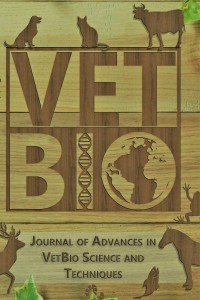Abstract
Hypoandrogenism is one of
the reasons for alopecia in humans, however it is rarely detected in dogs and
cats. To the best of the authors’ knowledge, this is the first retrospective
report describing only signalment and clinical manifestations of
hypoandrogenism in male dogs. A retrospective review of the medical records of
76 male dogs of different breeds and ages with hypoandrogenism from 1999 to
2017 were included to the study. The most common clinical signs were alopecia
that started from the tail to the neck and hyperpigmentation. This study
identified a variety of cutaneous lesions in male dogs with hypoandrogenism. As
there is relatively little published information describing hypoandrogenism in
animals, further studies are required to understand the importance of these endocrinopathies.
Keywords
References
- 1. Bratha-Robia, C.B., Egerbacher, M., Helmreich, M., Mıtteregger, G., Benesch, M., Bamberg, E. (2002). Immunohistochemical localization of androgen and oestrogen receptors in canine hair follicules. Vet Dermatol, 13, 113-118.2. Crabtree, J.S., Kilbourne, E.J., Peano, B.J., Chippari, S., Kenney, T., McNally, C., Wang, W., Harris, H.A., Winneker, R.C., Nagpal, S., Thompson, C.C. (2010). A Mouse model of androgenetic alopecia. Endocrinology, 15(5), 2373-2380.3. Cerundolo, R. (2009). Sex hormone alopecia in dogs. Comp. Anim. 14(8):1-5.4. Feldman, E.C., Nelson, R.W. (1996). Canine and Feline Endocrinology and reproduction. W. B. Saunders, Philadelphia. p. 645. Frank, L.A., Hnılıca, K.A., Rohrbach, B.W., Oliver, J.W. (2003). Retrospective evaluation of sex hormones and steroid hormone intermediates in dogs with alopecia. Vet Dermatol, 14, 91-97.6. Gündüz, A.Ü., Gündüz, M.C., Bilgiç, İ., Arun, S. (2002). Dermatosis in a german shepherd with hyperestrogenism, hypoandrogenizm and hypersensitivity. KHVHD, 19-22.7. Ginel, P.J., Lucina, R., Millan, Y., Gonzales-Medina, S., Guil, S., Garcia-Monterde, J., Espinosa de los Monteros, A., Martın de los Mulas, J. (2009). Expression of oestrogen and progesterone reseptors in canine sebaceous glandtumours. Vet Dermatol, 21, 297-302.8. Rosychuck, R.A.W. (2008). Cutaneous manifestations of endocrine disease in Dogs. The Compendium, 20(3), 287-302.9. Schmeitzel, L.P. (1990). Sex hormone-related and growth hormone-related alopecias. Vet Clin of North America: Small Anim Pract, 20(6), 1579-1601. 10. Scott, D.W., Miller, W.H., Griffin, C.E. (2001). Endocrine and metabolic diseases. In: Muller & Kirk’s small animall animal dermatology 6th edn. W. B. Saunders, Philadelphia. p 796-797 11. Scott, D.W., Paradis, M.A. (1990). Survey of canine and feline skin disorders seen in a university practise: Small animal clinic, university of Montreal, Saint-Hyacinthe, Quebec (1987-1988). Can Vet Journal, 31, 30-835.12. Mulligan, R.M. (1944). Feminization in male dogs a syndrome associated with carcinoma of the testis and mimicked by the administration of estrogens. Amer Journ of Pathol, 20(5), 865-875.
Abstract
Kedi ve köpeklerde nadir
olarak saptanmasına rağmen hipoandrojenizm insanlardaki alopesinin
nedenlerinden birisidir. Yazarların bilgisine göre, bu çalışma erkek köpeklerde
sadece hipoandrojenizmin anamnez ve klinik belirtilerini açıklayan ilk
retrospektif rapordur. 1999 ile 2017 yılları arasında farklı ırk
ve yaş gruplarında 76 erkek köpeğin tıbbi kayıtları retrospektif olarak
incelendi ve çalışma kapsamında değerlendirildi. En sık görülen klinik
bulgular, kuyruktan boyun bölgesine kadar uzayan alopesi ve hiperpigmentasyondu.
Bu çalışma, erkek köpeklerde hipoandrojenizmi olan çeşitli kutanöz lezyonları
tanımlamıştır. Hayvanlarda hipoandrojenizmi tanımlayan nispeten az yayınlanmış
bilgi olduğu için, bu endokrinopatilerin önemini anlamak için daha fazla
çalışmaya ihtiyaç vardır.
Keywords
References
- 1. Bratha-Robia, C.B., Egerbacher, M., Helmreich, M., Mıtteregger, G., Benesch, M., Bamberg, E. (2002). Immunohistochemical localization of androgen and oestrogen receptors in canine hair follicules. Vet Dermatol, 13, 113-118.2. Crabtree, J.S., Kilbourne, E.J., Peano, B.J., Chippari, S., Kenney, T., McNally, C., Wang, W., Harris, H.A., Winneker, R.C., Nagpal, S., Thompson, C.C. (2010). A Mouse model of androgenetic alopecia. Endocrinology, 15(5), 2373-2380.3. Cerundolo, R. (2009). Sex hormone alopecia in dogs. Comp. Anim. 14(8):1-5.4. Feldman, E.C., Nelson, R.W. (1996). Canine and Feline Endocrinology and reproduction. W. B. Saunders, Philadelphia. p. 645. Frank, L.A., Hnılıca, K.A., Rohrbach, B.W., Oliver, J.W. (2003). Retrospective evaluation of sex hormones and steroid hormone intermediates in dogs with alopecia. Vet Dermatol, 14, 91-97.6. Gündüz, A.Ü., Gündüz, M.C., Bilgiç, İ., Arun, S. (2002). Dermatosis in a german shepherd with hyperestrogenism, hypoandrogenizm and hypersensitivity. KHVHD, 19-22.7. Ginel, P.J., Lucina, R., Millan, Y., Gonzales-Medina, S., Guil, S., Garcia-Monterde, J., Espinosa de los Monteros, A., Martın de los Mulas, J. (2009). Expression of oestrogen and progesterone reseptors in canine sebaceous glandtumours. Vet Dermatol, 21, 297-302.8. Rosychuck, R.A.W. (2008). Cutaneous manifestations of endocrine disease in Dogs. The Compendium, 20(3), 287-302.9. Schmeitzel, L.P. (1990). Sex hormone-related and growth hormone-related alopecias. Vet Clin of North America: Small Anim Pract, 20(6), 1579-1601. 10. Scott, D.W., Miller, W.H., Griffin, C.E. (2001). Endocrine and metabolic diseases. In: Muller & Kirk’s small animall animal dermatology 6th edn. W. B. Saunders, Philadelphia. p 796-797 11. Scott, D.W., Paradis, M.A. (1990). Survey of canine and feline skin disorders seen in a university practise: Small animal clinic, university of Montreal, Saint-Hyacinthe, Quebec (1987-1988). Can Vet Journal, 31, 30-835.12. Mulligan, R.M. (1944). Feminization in male dogs a syndrome associated with carcinoma of the testis and mimicked by the administration of estrogens. Amer Journ of Pathol, 20(5), 865-875.
Details
| Primary Language | English |
|---|---|
| Subjects | Veterinary Surgery |
| Journal Section | Research Articles |
| Authors | |
| Publication Date | December 31, 2018 |
| Submission Date | July 20, 2018 |
| Acceptance Date | November 29, 2018 |
| Published in Issue | Year 2018 Volume: 3 Issue: 3 |




